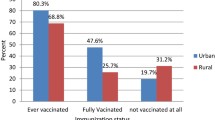Abstract
The dependence of immunization coverage of children in the municipalities of Vienna and Klagenfurt on the sociodemographic variables of their parents is investigated. According to the Austrian vaccination program, the following vaccinations are recommended: diphtheria/tetanus (DT), measles/mumps (MM), poliomyelitis (oPV), tickborne encephalitis (TBE), tuberculosis (BCG) and whooping cough (P). The aim of the study is to identify risk groups, as are children that are not well covered. A cross-sectional study using vaccination certificates of second grade schoolchildren in Vienna and Klagenfurt was performed. A multivariate logistic regression model is used. In Vienna a representative sample of second grade schoolchildren (n = 585) was investigated, in Klagenfurt all second grade schoolchildren (n = 824). The investigation took place during the 1993/1994 schoolyear. In Vienna 34.8% of the children have all the vaccinations recommended, in Klagenfurt 59.6%. Children of Austrian mothers have the best immunization coverage, followed by children whose mothers are from ‘other countries’, ‘not stated’, and ‘former Yugoslavia’. The immunization rate increases with the motherÕs increasing age. It is lower if the father is unemployed. The effects of the variables age and unemployment are not dependent on nationality. Children from Klagenfurt are more often completely immunized than children from Vienna. The mother's education does not have a significant influence. The Austrian immunization program is not sufficient to provide a high level of herd immunity. The immunization program recommends vaccinations but does not include a system for finding and recording riskgroups (non-immunized). To improve the situation eight steps needed for a setup of surveillance and containment system are recommended.
Similar content being viewed by others
References
Haschke F, Haidinger G, Haschke N, Zehetgruber H, Vutuc Ch. Impfstatus Wiener Schüler zweiter Volksschulklassen. Paediatr Paedol 1994; 29: 71–74.
Haidinger G, Plank R, Geiszler R, Migglautsch G, Pillaj E, Vutuc Ch. Durchimpfungsraten bei Klagenfurter Volksschülern. Mitt Öst Sanit Verwalt 1995; 2/3: 59–60.
Haschke F, Schilling R, Thun-Hohenstein L, Schuster E. Säuglingsernährung in Österreich. Wien, Österreich: Bundesministerium für Gesundheit und Umweltschutz 1985; Originalarbeiten, Studien, Forschungsberichte.
Impfplan 1988. In: Bundesministerium für Gesundheit und Umweltschutz, eds, 1988, Vienna.
SAS/STAT User's Guide, Version 6, Fourth Edition, Volume 2. Cary, NC: SAS Institute Inc., 1989.
Hosmer DWI, Lemeshow S. Applied logistic regression. New York: John Wiley & Sons, 1989.
Espinal MA, Cruz-Bello J, Perez EN, Marranzini B. A hospital based survey of BCG coverage in Santo Domingo, the Dominican Republic. Bull Pan Am Health Organ 1994; 28(1): 1–8.
Fielding JE, Cumberland WG, Pettitt L. Immunization status of children of employees in a large corporation. JAMA 1994; 271(7).
Stehr-Green PA, Dini EF, Lindegren ML, Patriarca PA. Evaluation of telephoned computer-generated reminders to improve immunization coverage at inner-city clinics. Public Health Reports 1993; 108(4): 426–430.
Schmitt L. Durchimpfungsgrad der Zehnjährigen bei Poliomyelitis, Diptherie, Tetanus, Pertussis, Masern und Mumps. Öff. Gesundh Wes 1984; 46: 494–496.
Haidinger G, Gredler B. Bekanntheitsgrad, Anwendungshäufigkeit und Erfolg alternativer Heilmethoden in Österreich — Ergebnisse einer Bevölkerungsbefragung. Öff Gesundh Wes 1988; 50: 9–12.
Bouvier P, Valdez E, Toscani L, Restellini JP, Rougemont A. Couverture vaccinale des enfants de 2 ans à Genève. Soz Präventivmed 1994; 39: 56–62.
Peltola H, Heinonen OP, Valle M, Paunio M, Virtanen M, Karanko V, Cantell K. The elimination of indigenous measles, mumps, and rubella from Finland by a 12-year, two-dose vaccination program. N Engl J M 1994; 331: 1397–1402.
Author information
Authors and Affiliations
Rights and permissions
About this article
Cite this article
Waldhoer, T., Haidinger, G., Vutuc, C. et al. The impact of sociodemographic variables on immunization coverage of children. Eur J Epidemiol 13, 145–149 (1997). https://doi.org/10.1023/A:1007359632218
Issue Date:
DOI: https://doi.org/10.1023/A:1007359632218




